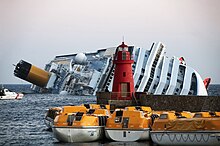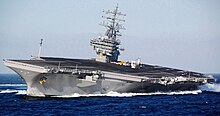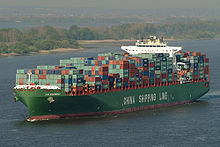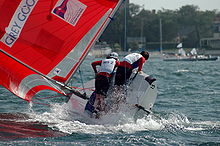Capsize

Capsize ( English canting , French chavirer ) is in the shipping a boat accident in which a water vehicle by wind , waves , or by displacement of the ship cargo is thrown to the side and by flooding swims more or less stable on the side or entirely tilts.
General
The word capsize, which comes from the sailor's language , has its origin in the edge, "put on the edge", in the artisan language "edge". Almost all languages took over the capsizing ( Dutch kanteren , Swedish kantra , Norwegian kantre , Danish kæntre ). The heeling precedes the capsizing, with the watercraft leaning to one side and turning around the longitudinal axis. If the ship continues to turn around its longitudinal axis, one speaks of overturning . If it hits the capsize angle , the actual capsize begins. Finally it drifts “ keel up”.
conditions
A watercraft capsizes when
- its stability (its ability to resist a change in swimming position) is less than an external force acting against it and the vehicle is forced into another stable swimming position or
- a change in the center of gravity (e.g. due to the ingress of water or slipping cargo) shifts the stable swimming position.
Ships and larger boats are not designed to capsize, and once capsized, they can sink if they are filled with water through openings that are normally above water. So capsizing here is extremely dangerous for ship and crew. Smaller boats - open sails dinghies and in particular canoes - capsize relatively frequently, and leaving and / or straightening the boat after capsizing are part of the basic knowledge of the relevant water sports enthusiast. Even on small sailing boats, however, there is a certain potential for injury if the crew is thrown against the mast and the shrouds , whereas for canoeists there is a general danger from rocks under water or drowning.
Rescue cruisers are built to be safe from overturning because they have to leave the port even in the most adverse conditions. This does not mean that they cannot overturn (through), but they straighten themselves up again from every swimming position (so - called self - righting ). Nevertheless, this is dangerous for the crew because it does not prevent someone from falling uncontrollably through the ship or going overboard.
Capsizing causes


Human error usually leads to all of the following causes of capsizing, for example due to navigation errors (obstacles in the water), incorrect steering in high seas, incorrect assessment of the weather situation (wind and sail guidance), incorrect stowage (passing cargo), incorrect trim, etc.
Wind and water
Large waves or rough seas can capsize, especially if they run sideways towards the vessel. It can also happen that a ship overturns over the bow if the stern is raised in the aft , breaking sea and the bow "seizes" in the next wave flank.
Wind can cause capsizing in the form of strong crosswinds or strong gusts of wind , especially if they occur unexpectedly or are accompanied by errors in steering . This danger exists especially with pleasure boats when thunderstorms or foehn storms are approaching if the sail area is not reduced in time , but also with large cargo ships (e.g. highly loaded container ships) at sea.
In sailing boats, the stability is also briefly reduced if the boat makes certain course changes relative to the wind without adjusting the sail position: If the sailboat drops on close-hauled courses , the wind pressure in the sail increases for a short time because the wind is now increasing offers a larger sail area; the heel (side tilt) increases. Also luffing on downwind courses leads in the short term to higher wind pressure and stronger heel. Such maneuvers can lead to capsizing if the stability of the boat has already been reduced (e.g. due to strong winds).
Water currents, especially different currents with strong intersection lines or eddy lines , can also lead to capsizing. Most of the time, when crossing the intersection line, the bow is caught by the new direction of flow and torn around, causing the ship to make a very tight curve. Due to its inertia, the ship cannot follow the rapid change in movement and leans on the outside of the curve. In strong current areas and on flat boats (e.g. whitewater paddling), the effect is exacerbated by the fact that at this moment current water flows over the deck of the boat and thus further destabilizes it. If there is sufficient loss of stability, the vehicle capsizes on the outside of the curve.
Obstacles in the water, such as sandbars , rocks, reefs , groynes , bridge piers , buoys or other sea marks , can capsize boats if they are hit (sideways). On lakes and large rivers, there are usually surprising, undiscovered obstacles. In white water paddling , on the other hand, they represent part of the sought-after challenge.
Cargo and weight shifts on board
The cargo in the form of uniform loading and load securing is crucial for the stability of the ship and its security against capsizing , especially in cargo ships . The cargo officer is responsible for this . In addition to sliding cargo (see e.g. Pamir ), there is also a risk of too much water in the ship, as the water has a very negative effect on swimming stability. In sea wars , it was often not the damage caused by fire , torpedo or mine that led directly to the sinking, but only the penetrating water reduced the stability until the ship capsized.
The (voluntary) weight shift has a similar effect on smaller boats (so-called trim on sailing boats ). Light boats like many canoes and dinghies can not only be steered through controlled shifting of weight, but also need them to compensate for currents and waves (especially edges in canoes) and lateral wind pressure ( heel in sailing boats). An incorrect weight shift, however, also leads to capsizing. Such an incorrect shift in weight can also occur on rowing boats and canoes through (unintentionally) undercutting oar or paddle blades : If the blade cuts through the water without resistance, rowers and paddlers can use the movement they usually use to work against the water pressure Capsize boat; In addition, any planned steering or straightening maneuver (e.g. paddle support ) becomes partially or completely ineffective due to undercutting, which impairs the stability even more.
Skip the water ballast
Passing over the water ballast also leads to capsizing, which means that stability is lost. Other causes of capsizing are the longitudinal swell and driving at an angle to the direction of the swell.
Mixed form: hard change of course

Hard course changes can capsize small boats, whereby the current around the moving boat and the inertia of the boat's mass work together unfavorably. Turbulence in the water generally affects the stability of boats, a hard (i.e. extremely) turned rudder is at an angle that deviates significantly from the keel line and the direction of travel of the boat; the water can no longer flow around such a rudder in a laminar manner , which leads to turbulence. In addition, if the course changes hard, the inertia of the boat acts in the previous direction of travel; so it is not only moved forward but also sideways. For such sideways movements, boats are naturally not built in a streamlined manner, so that a break in the laminar flow and thus additional turbulence can occur.
A boat moving in relation to the carrying medium is braked by the water, especially when there is turbulence. These braking forces act on the keel, not above the surface of the water, which is why the boat tilts - in the previous direction of movement. If the course change is initiated, this no longer corresponds to its longitudinal axis, which is why the boat rolls and heels , leans sideways. Boats are generally not very stable in a sideways direction, and stability decreases from a certain angle of inclination. If the heel angle exceeds the (dynamic) capsize angle given for the boat , the righting lever arm on the boat side becomes zero. In commonly built small boats and dinghies, this capsizing point is at a heel angle of around 90 °.
On sailing boats, depending on the course correction, there can be an additional loss of stability due to the changed wind pressure in the sail (see above ).
Capsizing: sideways, over the bow or over the stern
Large ships generally capsize sideways because they are too heavy and waves and obstacles too small to affect their longitudinal stability.
Boats also mostly capsize sideways, but sometimes also over the bow. With optimists z. B. a strong aft wind ("tail wind") can be enough to push the bow into the water and cause the boat to roll over. Due to the arrangement of the hull and the distance between the hulls, trimarans can hardly capsize sideways and therefore generally run a higher risk of capsizing over the bow if, for example, it dips into a wave flank due to hard course changes.
Canoes also capsize mostly sideways. Above all, shorter canoes, which can even be intentionally set up on the bow or stern when play boating and squirt boating - forms of whitewater paddling - can also capsize over the bow or stern.
Racing boats , especially the very fast ones of offshore powerboat racing , can take off due to the high speed and overturn in the air.
Measures against capsizing
There are no vessels that cannot be capsized, e.g. B. can capsize a submarine. Only life rafts or buoys with a ball-like or barrel-like structure and a weight keel are safe from overturning as long as no water penetrates.
Rigid sailing boats (dinghies)
With most dinghies , their dimensional stability protects them from capsizing. Capsizing is prevented by " riding out ". The sailors bring their body weight to the windward side . Alternatively or at the same time, the sails are opened a little ( lowered ), or the ship is turned towards the wind ( luffing ), which creates less wind pressure and therefore less heeling. In strong winds, the heeling and the risk of capsizing are reduced by reducing the sail area ( reefing , or lifting large sails and setting smaller sails).
With many (sportier) types of dinghies (especially those with a round frame , for example laser ), capsizing is a normal process. In the course of capsizing, a trained crew can even manage to “capsize without getting wet” by “stepping over” on the sword and also to straighten the ship again.
A cruising catamaran can only be set up again after capsizing with outside help. For this reason, a hatch for an emergency exit is installed in its hull just above the waterline, which is well above the waterline after capsizing and thus allows an exit even in moderate seas.
Weight stable sailing boats (yachts)
In yachts, the weight stability created by the ballast keel protects against capsizing. With increasing heel, the keel has an increasingly righting effect and at the same time the heel reduces the sail area exposed to the wind. This also explains the great danger that the rare partial or total losses of the keel - for example as a result of material failure or not fully developed innovative keel designs - bring with them.
Yachts with an intact keel usually straighten up again after they have “laid flat on the water”. When yachts capsize, they do not overturn (solely) as a result of the wind, but usually as a result of breaking waves. Most of the time they capsize completely. Sometimes yachts straighten up again afterwards (turn once around the longitudinal axis); this usually results in severe damage to the rig and the ship and serious injuries to the crew.
Weight stable ships
Passenger and cargo ships derive their stability from both weight and the shape of the hull. A keel with a heavy keel weight can delay capsizing ( weight stability ). In the case of large ships, capsizing can possibly be prevented by counter-flooding .
Canoes
Canoes derive their stability mainly from the shape of the hull. Depending on the construction, the stability of an immobile canoe is relatively low. Canoes for flat water races in particular get their stability, similar to bicycles , largely through movement; Beginners often capsize on lightly built flat-water canoes before they have even dipped a paddle into the water. But also on whitewater the forward movement supports the stability.
With the Eskimo roll or, if necessary, the Eskimo rescue , a capsized canoe can be straightened up again without having to get out. As a result, frequent capsizing, especially when whitewater paddling , is generally accepted cheaply. If the canoeist has to leave the boat, the water that has penetrated the canoe can be emptied and the boat can be re-boarded ; or the canoe can be brought to shore while swimming or with a throw line and the water that has entered can be emptied there before the boat is re-boarded. A paddle float can also be used to straighten a capsized canoe.
Edging and the paddle support are particularly helpful as a technique against capsizing . The edging deliberately tilts the canoe so as to reduce or prevent inadvertent reverse tilt caused by the current. The stability is thus initially reduced in a controlled manner (edges) in order to be able to maintain it afterwards.
Web links
Individual evidence
- ↑ Walther Mitzka, Trübner's German Dictionary , Volume IV, 1943, p. 130
- ↑ August Schiebe , Textbook of Contor Science , Part I, 1853, p. 533 FN 2-7
- ↑ Johannes Müller / Joseph Krauß (eds.), Handbook for Ship Control: Shipping Law and Maneuvering: Part A Schifffahrtsrecht I , Maneuvering , 1988, p. 196 f.




